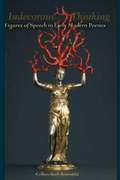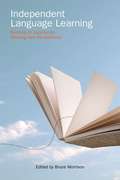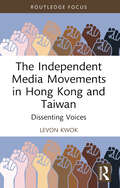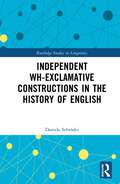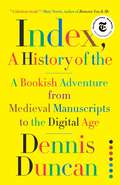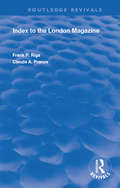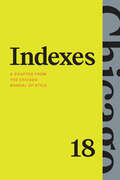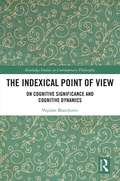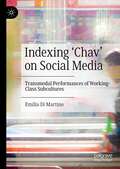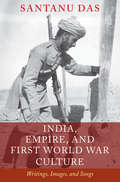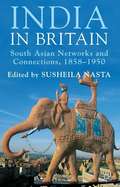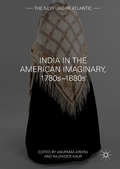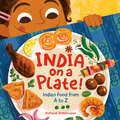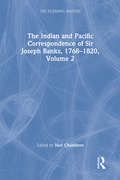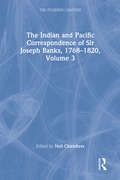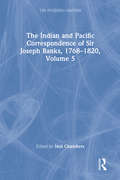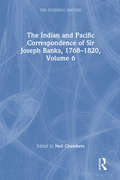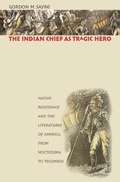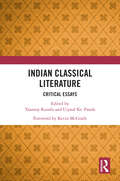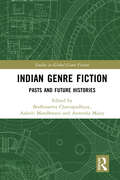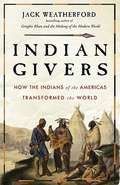- Table View
- List View
Indecorous Thinking: Figures of Speech in Early Modern Poetics
by Colleen Ruth RosenfeldIndecorous Thinking is a study of artifice at its most conspicuous: it argues that early modern writers turned to figures of speech like simile, antithesis, and periphrasis as the instruments of a particular kind of thinking unique to the emergent field of vernacular poesie. The classical ideal of decorum described the absence of visible art as a precondition for rhetoric, civics, and beauty: speaking well meant speaking as if off-the-cuff. Against this ideal, Rosenfeld argues that one of early modern literature's richest contributions to poetics is the idea that indecorous art—artifice that rings out with the bells and whistles of ornamentation—celebrates the craft of poetry even as it expands poetry’s range of activities. Rosenfeld details a lost legacy of humanism that contributes to contemporary debates over literary studies’ singular but deeply ambivalent commitment to form. Form, she argues, must be reexamined through the legacy of figure. Reading poetry by Philip Sidney, Edmund Spenser, and Mary Wroth alongside pedagogical debates of the period and the emergence of empiricism, with its signature commitment to the plain style, Rosenfeld offers a robust account of the triumphs and embarrassments that attended the conspicuous display of artifice. Drawing widely across the arts of rhetoric, dialectic, and poetics, Indecorous Thinking offers a defense of the epistemological value of form: not as a sign of the aesthetic but as the source of a particular kind of knowledge we might call poetic.
Independent Language Learning
by Bruce MorrisonIndependent learning is not a new concept for language educators but while teachers, curriculum designers and policy makers have embraced it as underpinning modern notions of education, it remains a dynamic and vibrant field for researchers and academics who aim to broaden its scope and deepen our understanding of how it may be applied most effectively both inside and outside the classroom. The book's authors use their experience of applying the concepts related to independent learning in various geographical, cultural and pedagogical tertiary level learning contexts to present new perspectives on how independent learning can inform and support policy, teaching methodology, curriculum development and the nurturing of successful learners. While the first section of the book provides a view of the field from three broad curriculum development viewpoints, the remaining chapters primarily focus on the experience of learners, teachers and curriculum developers in applying principles of learner autonomy, self-regulation and self-direction with various types of learner - each with their own identities, motivations, expectations and goals. These learner and teacher stories provide insights that are important for an understanding of some of the impacts an independent learning approach to language learning have on learners in various educational contexts. This book will be of value to pre-service and in-service teachers, curriculum developers and teacher educators working in diverse educational contexts in more fully appreciating the contribution an independent learning focus can make to successful learning.
The Independent Media Movements in Hong Kong and Taiwan: Dissenting Voices (Routledge Focus on Asia)
by Levon KwokThis book examines the independent media movements by Inmediahk and Coolloud – long-established, autonomous media organizations that have agitated for the development of media freedom and human rights in Hong Kong and Taiwan since 2004 and 1997, respectively. Based on direct interviews with the founders and core members of Inmediahk and Coolloud, the author investigates the origins, growth, and achievements of Inmediahk and Coolloud's media social movements as well as the current challenges the two independent media outlets encounter with regard to funding, increasing socio-political pressure, and the complicated media environments in Hong Kong and Taiwan using the method of qualitative content interpretation. Moreover, the practicality of social media and independent media in contemporary social movements, including the 2019 Anti-Extradition Bill Movement in Hong Kong, is reviewed according to text analysis. Considering the prospect of media activism from a non-western perspective, this book will appeal not only to scholars and researchers with interests in media, social movement, and cultural studies, but also to media workers and activists across the globe.
Independent Wh-Exclamative Constructions in the History of English (Routledge Studies in Linguistics)
by Daniela SchröderThis book offers the first book-length treatment of the diachronic study of English exclamatives, tracing their development from 1500 through to the twenty-first century.The volume shines a light on independent wh-exclamatives in the history of English. In particular, Schröder calls attention to the development of three prototypical wh-exclamatives as observed in three newly created genre-balance corpora comprising prose fiction, dialogues, and personal correspondence, uncovering new insights into the differences in their evolution. In its analysis of English exclamatives over time and broader exploration of the impact of genre on constructional productivity, the book raises key questions about existing claims in scholarship on Diachronic Construction Grammar and outlines ways forward for new areas of inquiry. This volume will appeal to scholars interested in diachronic linguistics, historical syntax, language variation and change, and the history of English.
Index, A History of the: A Bookish Adventure from Medieval Manuscripts to the Digital Age
by Dennis DuncanA New York Times Editors' Choice Book and a New Yorker Best Book of 2022 So Far Named a Most Anticipated Book of 2022 by Literary Hub and Goodreads A playful history of the humble index and its outsized effect on our reading lives. Most of us give little thought to the back of the book—it’s just where you go to look things up. But as Dennis Duncan reveals in this delightful and witty history, hiding in plain sight is an unlikely realm of ambition and obsession, sparring and politicking, pleasure and play. In the pages of the index, we might find Butchers, to be avoided, or Cows that sh-te Fire, or even catch Calvin in his chamber with a Nonne. Here, for the first time, is the secret world of the index: an unsung but extraordinary everyday tool, with an illustrious but little-known past. Charting its curious path from the monasteries and universities of thirteenth-century Europe to Silicon Valley in the twenty-first, Duncan uncovers how it has saved heretics from the stake, kept politicians from high office, and made us all into the readers we are today. We follow it through German print shops and Enlightenment coffee houses, novelists’ living rooms and university laboratories, encountering emperors and popes, philosophers and prime ministers, poets, librarians and—of course—indexers along the way. Revealing its vast role in our evolving literary and intellectual culture, Duncan shows that, for all our anxieties about the Age of Search, we are all index-rakers at heart—and we have been for eight hundred years.
Index to Modern English
by Thomas Lee CrowellSaxon series in English as a second language. Answers questions on pronunciation, grammatical terminology, morphology, syntax, use of prepositions, spelling, punctuation, literary devices, style, and divided usage.
Index to the London Magazine (Routledge Revivals)
by Frank P. Riga Claude A. PranceThis book was originally published in 1978. The London Magazine is briefly told in the accomplisments and failures of its four editors, and during the fourteen months of his editorship, 1820-21, John Scott succeeded in establishing the London as one of the finest literary periodicals of the nineteenth century. John Taylor, the second editor, maintained the high quality of the magazine by securing many excellent writers. But by the end of 1825, the first year of Henry Southern's editorship, the magazine had lost most of its distinguished writers. When Charles night began editing the London in 1828, its great period was already a memory. This book presents a brief history of the magazine alongside the index.
Indexes: A Chapter from "The Chicago Manual of Style," Eighteenth Edition
by The University of Chicago Press Editorial StaffIndexing A–Z from The Chicago Manual of Style—the undisputed authority for style, usage, and grammar. In this age of searchable text, the need for an index made with human input is sometimes questioned. But a good index can do what a plain search cannot: It gathers all the substantive terms and subjects of the work, sorts them alphabetically, provides cross-references to and from related terms, and includes specific page numbers or other locators or, for electronic formats, direct links to the text. This painstaking intellectual labor serves readers of any longer work, whether it is searchable or not. For searchable texts, an index provides insurance against fruitless queries and unintended results. In a word, a good index makes the text more accessible. Most book indexes must be assembled swiftly between the time page proofs are issued and the time they are returned to the typesetter—usually about four weeks. An author preparing their own index will have to proofread as well as index the work in that short time span. This insightful chapter-length booklet will guide both professionals and first-time indexers in assembling an index that will do justice to both the book and the reader.
The Indexical Point of View: On Cognitive Significance and Cognitive Dynamics (Routledge Studies in Contemporary Philosophy)
by Vojislav BozickovicThis book argues that there is a common cognitive mechanism underlying all indexical thoughts, in spite of their seeming diversity. Indexical thoughts are mental representations, such as beliefs and desires. They represent items from a thinker's point of view or her cognitive perspective. We typically express them by means of sentences containing linguistic expressions such as 'this (F)' or 'that (F)', adverbs like 'here', 'now', and 'today', and the personal pronoun ‘I’. While generally agreeing that representing the world from a thinker's cognitive perspective is a key feature of indexical thoughts, philosophers disagree as to whether a thinker's cognitive perspective can be captured and rationalized by semantic content and, if so, what kind of content this is. This book surveys competing views and then advances its own positive account. Ultimately, it argues that a thinker's cognitive perspective - or her indexical point of view - is to be explained in terms of the content that is believed and asserted as the only kind of content that there is which thereby serves as the bearer of cognitive significance. The Indexical Point of View will be of interest to philosophers of mind and language, linguists, and cognitive scientists.
Indexing ‘Chav’ on Social Media: Transmodal Performances of Working-Class Subcultures
by Emilia Di MartinoThe book sets out to examine the concept of 'chav', providing a review of its origins, its characterological figures, the process of enregisterment whereby it has come to be recognized in public discourse, and the traits associated with it in traditional media representations. The author then discusses the 'chav' label in light of recent re-appropriations in social network activity (particularly through the video-sharing app TikTok) and subsequent commentary in the public sphere. She traces the evolution of the term from its use during the first decade of the twenty-first century to make sense of class, status and cultural capital, to its resurgence and the ways in which it is still associated with appearance in gendered and classed ways. She then draws on recent developments in linguistic anthropology and embodied sociocultural linguistics to argue that social media users draw on communicative resources to perform identities that are both situated in specific contexts of discourse and dynamically changing, challenging the idea that geo-sociocultural varieties and mannerisms are the sole way of indexing membership of a community. This volume contends that equating 'chav' with 'underclass' in the most recent uses of the concept on social networks may not be the whole story, and the book will be of interest to sociocultural linguistics and identity researchers, as well as readers in anthropology, sociology, British studies, cultural studies, identity studies, digital humanities, and sociolinguistics.
India and the Islamic Heartlands
by Gagan D. S. Sood"Based on the chance survival of a remarkable cache of documents, India and the Islamic Heartlands recaptures a vanished and forgotten world from the eighteenth century spanning much of today's Middle East and South Asia. Gagan Sood focuses on ordinary people--traders, pilgrims, bankers, clerics, brokers, scribes, among others--who were engaged in activities marked by large distances and long silences. By elucidating their everyday lives in a range of settings, from the family household to the polity at large, Sood pieces together the connective tissue of a world that lay beyond the sovereign purview. Recapturing this obscured and neglected world helps us better understand the region during a pivotal moment in its history, and offers new answers to old questions concerning early modern Eurasia and its transition to colonialism"--
India, Empire, and First World War Culture: Writings, Images, and Songs
by Santanu DasBased on ten years of research, Santanu Das's India, Empire, and First World War Culture: Writings, Images, and Songs recovers the sensuous experience of combatants, non-combatants and civilians from undivided India in the 1914–1918 conflict and their socio-cultural, visual, and literary worlds. Around 1.5 million Indians were recruited, of whom over a million served abroad. Das draws on a variety of fresh, unusual sources - objects, images, rumours, streetpamphlets, letters, diaries, sound-recordings, folksongs, testimonies, poetry, essays, and fiction - to produce the first cultural and literary history, moving from recruitment tactics in villages through sepoy traces and feelings in battlefields, hospitals, and POW camps to post-war reflections on Europe and empire. Combining archival excavation in different countries across several continents with investigative readings of Gandhi, Kipling, Iqbal, Naidu, Nazrul, Tagore, and Anand, this imaginative study opens up the worlds of sepoys and labourers, men and women, nationalists, artists, and intellectuals, trying to make sense of home and the world in times of war.
India in Britain
by Susheila NastaMoving away from orthodox narratives of the Raj and British presence in India, this book examines the significance of the networks and connections that South Asians established on British soil. Looking at the period 1858-1950, it presents readings of cultural history and points to the urgent need to open up the parameters of this field of study.
India in the American Imaginary, 1780s–1880s
by Anupama Arora Rajender KaurThis book seeks to frame the "the idea of India" in the American imaginary within a transnational lens that is attentive to global flows of goods, people, and ideas within the circuits of imperial and maritime economies in nineteenth century America (roughly 1780s-1880s). This diverse and interdisciplinary volume - with essays by upcoming as well as established scholars - aims to add to an understanding of the fast changing terrain of economic, political, and cultural life in the US as it emerged from being a British colony to having imperial ambitions of its own on the global stage. The essays trace, variously, the evolution of the changing self-image of a nation embodying a surprisingly cosmopolitan sensibility, open to different cultural values and customs in the late eighteenth and early nineteenth century to one that slowly adopted rigid and discriminatory racial and cultural attitudes spawned by the widespread missionary activities of the ABCFM and the fierce economic pulls and pushes of American mercantilism by the end of the nineteenth century. The different uses of India become a way of refining an American national identity.
India on a Plate!: Indian Food from A to Z
by Archana SreenivasanSpicy or tangy, savory or sweet—let&’s meet some Indian foods from A to Z! Warning: this book might make you very hungry!Fry, simmer, sauté, and create.I&’ll try them all. I can&’t wait!You can&’t fit India on a plate!Kids love learning about food, they need to learn their ABC's, and this mouth-watering alphabet book covers both in the most delicious way! From spicy achaar to sweet zafrani pulao, flip through food from every corner of India, for all kinds of occasions. Author/illustrator Archana Sreenivasan brings each dish to life with playful rhyming text and bright, engaging illustrations.
The Indian and Pacific Correspondence of Sir Joseph Banks, 1768–1820, Volume 2 (The Pickering Masters)
by Neil ChambersFollowing his participation in James Cook's circumnavigation in HMS Endeavour (1768-71), Joseph Banks developed an extensive global network of scientists and explorers. His correspondence shows how he developed effective working links with the British Admiralty and with the generation of naval officers who sailed after Cook. Volume 2 1768–1820.
The Indian and Pacific Correspondence of Sir Joseph Banks, 1768–1820, Volume 3 (The Pickering Masters)
by Neil ChambersFollowing his participation in James Cook's circumnavigation in HMS Endeavour (1768-71), Joseph Banks developed an extensive global network of scientists and explorers. His correspondence shows how he developed effective working links with the British Admiralty and with the generation of naval officers who sailed after Cook. Volume 3 Letters 1789–1792
The Indian and Pacific Correspondence of Sir Joseph Banks, 1768–1820, Volume 5 (The Pickering Masters)
by Neil ChambersFollowing his participation in James Cook's circumnavigation in HMS Endeavour (1768-71), Joseph Banks developed an extensive global network of scientists and explorers. His correspondence shows how he developed effective working links with the British Admiralty and with the generation of naval officers who sailed after Cook. Volume 5 Letters 1798–1801
The Indian and Pacific Correspondence of Sir Joseph Banks, 1768–1820, Volume 6 (The Pickering Masters)
by Neil ChambersFollowing his participation in James Cook's circumnavigation in HMS Endeavour (1768-71), Joseph Banks developed an extensive global network of scientists and explorers. His correspondence shows how he developed effective working links with the British Admiralty and with the generation of naval officers who sailed after Cook. Volume 6 Letters 1801–1805
The Indian Chief as Tragic Hero
by Gordon M. SayreThe leaders of anticolonial wars of resistance--Metacom, Pontiac, Tecumseh, and Cuauhtemoc--spread fear across the frontiers of North America. Yet once defeated, these men became iconic martyrs for postcolonial national identity in Canada, the United States, and Mexico. By the early 1800s a craze arose for Indian tragedy on the U.S. stage, such as John Augustus Stone's Metamora, and for Indian biographies as national historiography, such as the writings of Benjamin Drake, Francis Parkman, and William Apess.With chapters on seven major resistance struggles, including the Pueblo Revolt of 1680 and the Natchez Massacre of 1729, The Indian Chief as Tragic Hero offers an analysis of not only the tragedies and epics written about these leaders, but also their own speeches and strategies, as recorded in archival sources and narratives by adversaries including Hernan Cortes, Antoine-Simon Le Page du Pratz, Joseph Doddridge, Robert Rogers, and William Henry Harrison. Sayre concludes that these tragedies and epics about Native resistance laid the foundation for revolutionary culture and historiography in the three modern nations of North America, and that, at odds with the trope of the complaisant "vanishing Indian," these leaders presented colonizers with a cathartic reproof of past injustices.
Indian Classical Literature: Critical Essays
by Tanmoy Kundu and Ujjwal Kr. PandaThis book critically analyses classical Indian literature and explores the philosophical, literary, and cultural landscapes which have emerged in response to ancient Indian texts. It highlights the relevance of these texts and studies and how they have come to influence modern Indian literature in various ways. The authors look at classical literature both as a theoretical premise that primarily seeks to develop new knowledge and as a sphere of serious modern/postmodern critical attention. The volume features essays on key texts including Abhijnanasakuntalam, The Cilappatikaram: A Tale of An Anklet, Mrichchakatika, Panchatantra, and Mahabharata.A useful guide to ancient Indian texts, the book will be indispensable for students and researchers of mythology and classical literature, literary and critical theory, Indian literature, Sanskrit studies, and South Asian studies.
Indian English and the Fiction of National Literature
by Rosemary Marangoly GeorgeDuring the twentieth century, at the height of the independence movement and after, Indian literary writing in English was entrusted with the task of consolidating the image of a unified, seemingly caste-free, modernising India for consumption both at home and abroad. This led to a critical insistence on the proximity of the national and the literary, which in turn, led to the canonisation of certain writers and themes and the dismissal of others. Examining English anthologies of 'Indian literature', as well as the establishment of the Sahitya Akademi (the national academy of letters) and the work of R. K. Narayan and Mulk Raj Anand among others, Rosemary George exposes the painstaking efforts that went into the elaboration of a 'national literature' in English for independent India even while deliberating the fundamental limitations of using a nation-centric critical framework for reading literary works.
Indian Genre Fiction: Pasts and Future Histories (Studies in Global Genre Fiction)
by Bodhisattva Chattopadhyay Aakriti Mandhwani Anwesha MaityThis volume maps the breadth and domain of genre literature in India across seven languages (Tamil, Urdu, Bangla, Hindi, Odia, Marathi and English) and nine genres for the first time. Over the last few decades, detective/crime fiction and especially science fiction/fantasy have slowly made their way into university curricula and consideration by literary critics in India and the West. However, there has been no substantial study of genre fiction in the Indian languages, least of all from a comparative perspective. This volume, with contributions from leading national and international scholars, addresses this lacuna in critical scholarship and provides an overview of diverse genre fictions. Using methods from literary analysis, book history and Indian aesthetic theories, the volume throws light on the variety of contexts in which genre literature is read, activated and used, from political debates surrounding national and regional identities to caste and class conflicts. It shows that Indian genre fiction (including pulp fiction, comics and graphic novels) transmutes across languages, time periods, in translation and through publication processes. While the book focuses on contemporary postcolonial genre literature production, it also draws connections to individual, centuries-long literary traditions of genre literature in the Indian subcontinent. Further, it traces contested hierarchies within these languages as well as current trends in genre fiction criticism. Lucid and comprehensive, this book will be of great interest to academics, students, practitioners, literary critics and historians in the fields of postcolonialism, genre studies, global genre fiction, media and popular culture, South Asian literature, Indian literature, detective fiction, science fiction, romance, crime fiction, horror, mythology, graphic novels, comparative literature and South Asian studies. It will also appeal to the informed general reader.
Indian Givers: How the Indians of the Americas Transformed the World
by Jack Weatherford"As entertaining as it is thoughtful. . . . Few contemporary writers have Weatherford's talent for making the deep sweep of history seem vital and immediate. " THE WASHINGTON POST After 500 years, the world's huge debt to the wisdom of the Indians of the Americas has finally been explored in all its vivid drama by anthropologist Jack Weatherford. He traces the crucial contributions made by the Indians to our federal system of government, our democratic institutions, modern medicine, agriculture, architecture, and ecology, and in this astonishing, ground-breaking book takes a giant step toward recovering a true American history.
Indian Givers: How Native Americans Transformed the World
by Jack Weatherford"As entertaining as it is thoughtful....Few contemporary writers have Weatherford's talent for making the deep sweep of history seem vital and immediate."THE WASHINGTON POSTAfter 500 years, the world's huge debt to the wisdom of the Indians of the Americas has finally been explored in all its vivid drama by anthropologist Jack Weatherford. He traces the crucial contributions made by the Indians to our federal system of government, our democratic institutions, modern medicine, agriculture, architecture, and ecology, and in this astonishing, ground-breaking book takes a giant step toward recovering a true American history.From the Trade Paperback edition.
